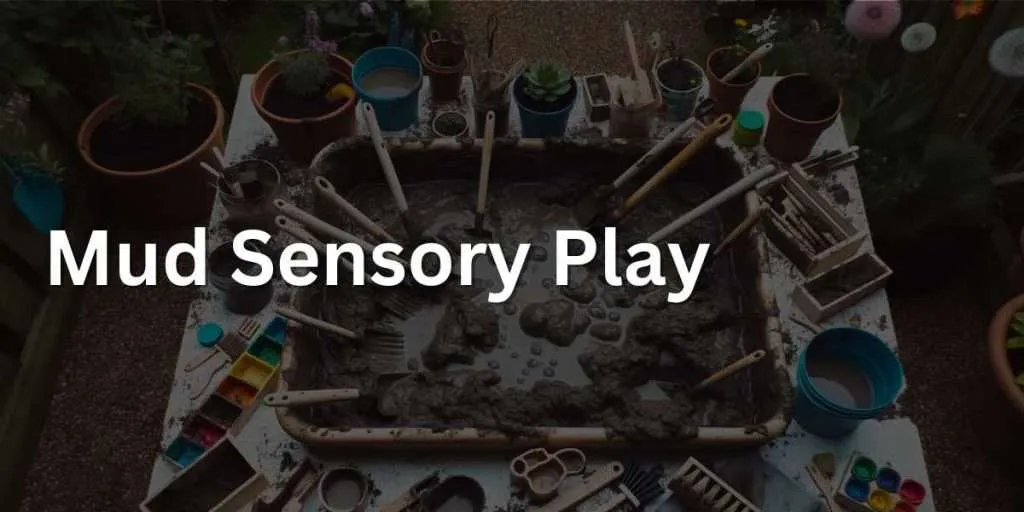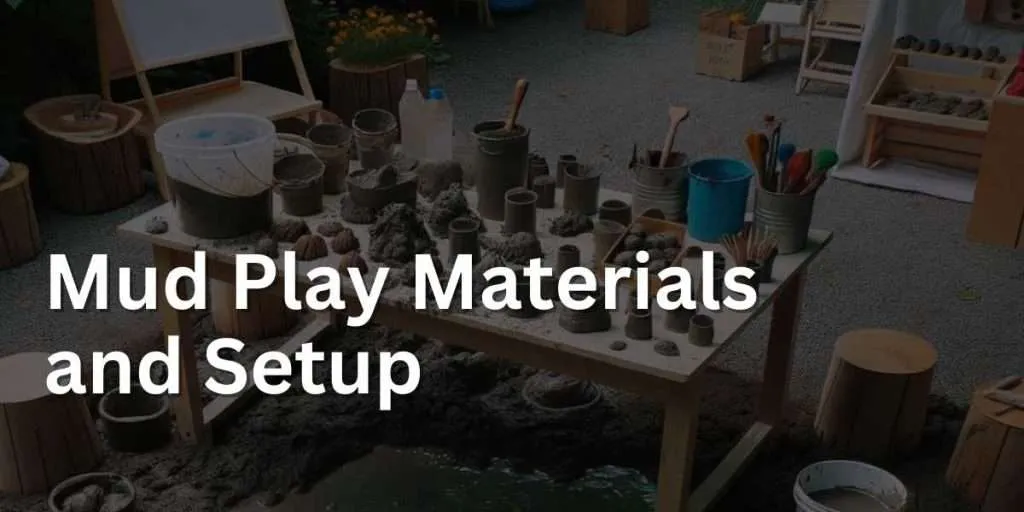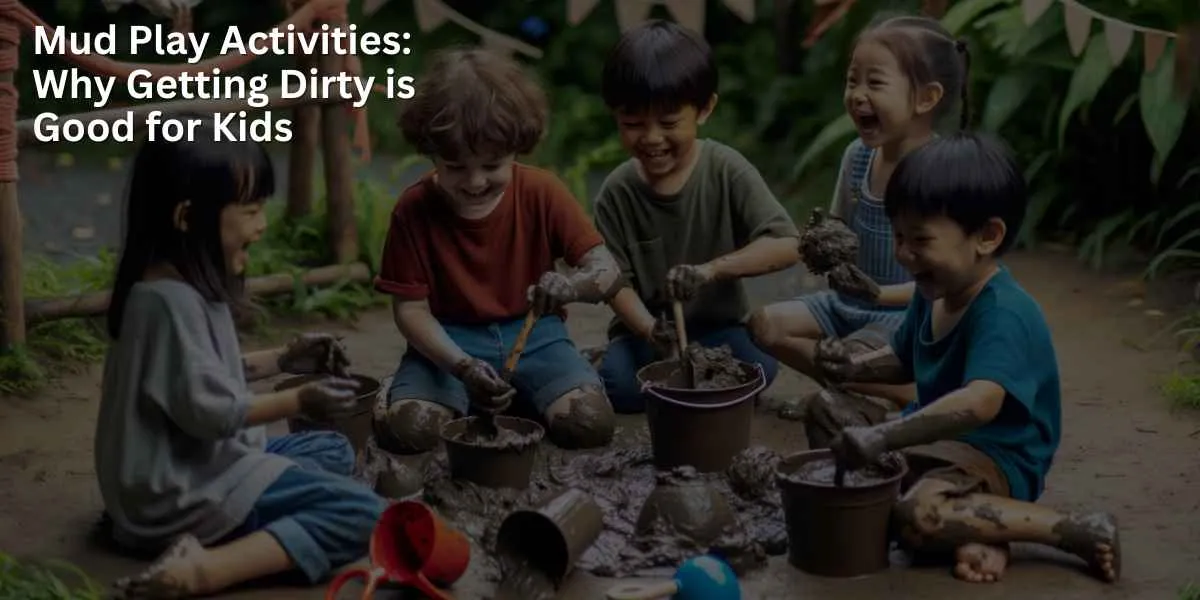Mud play activities unlock a world of sensory wonder. Ever watched your child gleefully squish mud between their fingers, constructing mud pies or sculptures, and wondered about the deeper benefits beyond the messy fun? If so, you’re not alone. Mud play, often a childhood staple, holds more significance than meets the eye.
Fortunately, recent studies and timeless observations alike have unveiled the multifaceted benefits of mud play, ranging from sensory development to fostering creativity.
As an expert in child development and play-based learning, I’ve delved into the rich world of mud play, unraveling its numerous advantages and its pivotal role in holistic child growth.
Let’s journey through this muddy terrain, uncovering the reasons why this messy form of play is, in fact, a treasure trove of developmental benefits.
The Basics of Mud Play
Mud play, often a favorite among children, offers a wealth of developmental, sensory, and health benefits.
Mud play is a fun and open-ended play experience that children of all ages can enjoy. Playing in the mud allows children to explore different textures, smells, and sounds all at once, which can be a sensory-rich experience.
When children play in the mud, they are getting dirty, which is a natural and important part of childhood. Playing in the mud allows children to connect with nature and the environment around them. It gives them the opportunity to learn about the world through hands-on experiences.
Mud play is a great way for young children to engage in outdoor play. Mud makes great fun and encourages creativity and imagination, and it allows children to take risks and explore their surroundings.
13 Creative Mud Play Ideas!
- Mud Kitchen: Set up an outdoor “kitchen” using old pots, pans, and utensils for stirring, mixing, and “baking” creating mud pies or mud soup.
- Mud Painting: Use mud as paint and thick paper or cardboard as a canvas. Add natural elements like leaves and sticks for texture.
- Muddy Tracks: Press different objects or feet and hands into the mud to observe and compare imprints.
- Mud Sculpture: Build and mold with wet mud to create figures, towers, or abstract shapes.
- Muddy Puddle Jumping: Find or create muddy puddles to splash and play in.
- Mudslide: On a gentle grassy slope and with parental supervision, make a mini mudslide to slide down.
- Muddy Water Channeling: Dig channels and use water to create rivers and streams in the mud.
- Mud Bath for Toys: Let kids give their waterproof toys a “mud bath” and then a cleaning session afterward.
- Mud Obstacle Course: Design a course with mud pits, mounds, and challenges to crawl through and over.
- Mud Sensory Bin: Fill a bin with mud and hidden treasures (like plastic insects) for kids to find using their sense of touch.
- Mud bricks: Create mud bricks using containers such as ice cube trays to mold mud in and allow them to dry.
- Mud fights: You haven’t lived until you have had some muddy play and throw mud balls.
- Mud pit play: Just get dirty and have messy play in a mud pit, children will soon come up with their own mud play activities. Early childhood just be full of just allowing children to play in the mud and other natural materials.
Engaging in mud play offers kids tactile sensory experiences, promotes creativity, and connects them to nature. Always supervise young children closely, especially around water or deep mud, and have a clean-up plan for when the muddy fun concludes!

Sensory and Cognitive Benefits
Playing with mud is not just about fun, but it also provides numerous sensory and cognitive benefits for children.
| Benefit Category | Description |
|---|---|
| Sensory Development | – Tactile experiences: Mud has a unique texture that stimulates the sense of touch. |
| – Integration of senses: Playing with mud often involves sight, touch, and sometimes smell, promoting multisensory integration. | |
| Cognitive Development | – Creativity boost: Mud can be molded, shaped, and used in imaginative play, fostering creativity. |
| – Problem-solving: Children figure out how to make mud pies, build structures, or divert water flows, enhancing critical thinking. | |
| – Scientific exploration: Kids observe the properties of mud, how water and soil mix, and how drying changes its consistency. | |
| Physical Development | – Fine motor skills: Manipulating mud and creating detailed structures or designs can refine fine motor abilities. |
| – Gross motor skills: Larger movements like digging, lifting, and splashing in mud contribute to the development of gross motor skills. | |
| Social Skills | – Collaboration: Children often work together during mud play, learning to cooperate, share, and communicate effectively. |
| – Role-playing: Mud kitchens or construction scenarios can involve taking on different roles, enhancing social play. | |
| Emotional Well-being | – Stress relief: The sensory experience of mud play can be therapeutic and calming, reducing stress and anxiety. |
| – Connection with nature: Engaging with a natural element like mud can deepen a child’s connection to the environment. | |
| – Boosted confidence: Achieving self-set goals, like building a mud castle, can enhance a child’s self-esteem. | |
| Health Benefits | – Enhanced immune system: Exposure to a bit of dirt can introduce harmless bacteria, which may help strengthen a child’s immune system over time. |
| – Increased Vitamin D: Playing outside in the sun, even when it’s muddy, aids in Vitamin D absorption through the skin. |
Engaging the Senses
Mud play is a sensory-rich experience that engages all of the senses. Children can explore different textures, smells, and sounds all at once. Feeling the sensation of cool mud on their hands, listening to it squish through their fingers, and inhaling the earthy smell elevates the experience of playing with dirt and water. This sensory play helps develop a child’s sense of touch, smell, and hearing.
Boosting Creativity and Imagination
Mud play offers endless opportunities for creative expression. Children can create mud sculptures, mud pictures/designs, and even mud body painting. The possibilities are endless, and it encourages children to think outside the box and use their imaginations. This creative thinking helps build problem-solving skills and resilience.
Developing Problem-Solving and Resilience
Mud play helps children develop problem-solving skills and resilience. As children create mud sculptures or designs, they learn how to plan, design, and execute their ideas. This process helps them develop critical thinking skills and resilience to overcome challenges and setbacks.
In summary, mud play offers numerous benefits for children’s sensory and cognitive development. It engages their senses, boosts creativity and imagination, and develops problem-solving skills and resilience. So, the next time your child wants to play in the mud, encourage them to do so and watch them develop into a creative and resilient problem solver.
Physical Benefits of Mud Play
Playing with mud offers several physical benefits for children. Here are some of them:
Fine and Gross Motor Skills Development
Mud play is an excellent way to develop fine and gross motor skills. When children play with mud, they use their hands and fingers to mold and shape the mud, which helps to develop their fine motor skills.
At the same time, they are also using their arms and legs to move around and manipulate the mud, which helps to develop their gross motor skills.
Exercise and Outdoor Space
Mud play also offers children the opportunity to exercise and move around in an outdoor space. When children play with mud, they are squatting, bending, reaching, and moving around, which helps to develop their muscles and improve their overall physical fitness.
Playing in an outdoor space offers children exposure to fresh air and sunlight, which can have a positive impact on their physical and mental health.
Social and Language Skills Enhancement
Mud play offers a unique opportunity for children to develop their social and language skills in a fun and engaging way. By engaging in cooperative play with others, children learn to communicate effectively, share ideas, and work together towards a common goal.
This type of open-ended play is crucial for developing problem-solving, social-emotional, and language skills.
When children play with mud, they are often engaged in imaginative play, creating stories and scenarios that involve different characters and situations. This type of play encourages children to use their language skills to communicate with others and express their ideas.
They learn to negotiate and compromise, as they work together to create their mud creations.
Mud play allows children to experiment with different social roles and scenarios, helping them to develop their social skills.
They learn to take turns, share resources, and work together to achieve a common goal. This type of cooperative play is essential for building strong relationships with others and developing a sense of empathy and understanding.
Emotional and Psychological Impact
Playing in the mud can have a significant emotional and psychological impact on children. It can create happy memories that they will cherish for years to come. These memories of carefree play can be a source of comfort and joy during difficult times in their lives.
As a parent, you want your child to have a happy childhood. Playing in the mud is a simple and fun way to create lasting childhood memories. It’s a chance for your child to explore and experiment with their surroundings in a safe and playful way.
Mud play can also have a positive impact on mental health. Playing in the mud can increase the production of serotonin in the brain, which is a chemical that helps regulate mood. This can be especially beneficial for children who struggle with depression or anxiety.
Childhood experiences can shape attitudes and behaviors in adulthood. By allowing your child to play in the mud, you are teaching them to appreciate the simple things in life and to find joy in the present moment. This can help them develop a positive attitude towards life and a greater appreciation for nature.

Mud Play and Immunity
Playing in mud can have a positive effect on your child’s immune system. Here are some reasons why:
Exposure to Bacteria and Allergens
When children play in mud, they are exposed to a variety of bacteria and allergens that can help build their immune system. Exposure to these germs can help strengthen their immune system and make them more resistant to illnesses and allergies.
Hygiene Hypothesis and Immune Systems
The hygiene hypothesis suggests that children who are exposed to more germs and bacteria during childhood have stronger immune systems. Mud play is a great way to expose your child to these germs and build a stronger immune system.
Research has shown that Mycobacterium Vaccae, a type of bacteria found in soil, can stimulate the immune system and increase the levels of serotonin in our brains. Serotonin is an endorphin that can improve mood and reduce anxiety.
Encouraging your child to play in mud and explore the natural world can be a fun and accessible way to build a stronger immune system. However, it’s important to balance this with good hygiene practices to prevent the spread of harmful bacteria and allergens.

Mud Play Materials and Setup
To set up a mud play area, you will need some basic materials. Here are some ideas:
- Pots and Utensils: Old pots and utensils are great for mud play. You can use them to mix and create different textures of mud, or to create mud pies and cakes.
- Local Materials: Look around your local area for natural materials to add to your mud play. Leaves, grass, pebbles, and twigs are all great additions to mud play.
- Waterways: If you have a natural waterway nearby, such as a stream or river, this can be a great addition to your mud play. Children can use the water to mix and create their mud, or to create channels and dams.
- Loose Parts: Loose parts are open-ended materials that children can use in a variety of ways. They can be used to create structures, add texture, or as tools for mud play. Some examples of loose parts include sticks, stones, and shells.
When setting up your mud play area, it’s important to consider safety. Make sure the area is free from hazards such as sharp objects or poisonous plants. You may also want to consider providing aprons or old clothes for children to wear, as mud play can get messy!
Once you have your materials, it’s time to start playing! Encourage children to explore the materials and use their imaginations to create different textures and structures. Mud play is a great opportunity for children to develop their creativity, problem-solving skills, and physical literacy. So get outside and start playing in the mud!
Incorporating Mud Play in Different Weather
Mud play is a fun and engaging way for children to connect with nature, discover new things, and learn through play. But what happens when the weather is not ideal for outdoor play? Don’t let a rainy day stop you from incorporating mud play into your child’s playtime. Here are some tips for incorporating mud play in different weather conditions:
Rainy Days
Rainy days are perfect for mud play. The rain helps to create the perfect consistency of mud for squishing, molding, and shaping. Put on some rain boots and raincoats and head outside to jump in mud puddles and making mud pies
. If you don’t have a designated mud play area, create one by laying down a tarp or using a shallow pool to contain the mud.
Hot and Dry Days
On hot and dry days, the ground can become hard and dry, making it difficult to create mud. To combat this, you can create your own mud by mixing water and soil in a bucket or container. Alternatively, you can use natural materials such as leaves, grass, and flowers to create mud-like textures and colors.
Cold and Snowy Days
In colder weather, mud play may not be possible but snow play activities are!. However, you can still incorporate natural materials into your child’s playtime. Use snow to create sculptures or add natural materials such as twigs and pinecones to create sensory bins. You can also bring mud play indoors by creating a mud kitchen or using sensory play dough.
Frequently Asked Questions
What are the benefits of letting children play in nature?
Playing in nature has numerous benefits for children. It allows them to explore and learn about the world around them, develop their imagination, and build their creativity. Spending time in nature also helps children develop a love and appreciation for the environment, which can lead to a desire to protect it.
What are the benefits of sensory play?
Sensory play is an important part of a child’s development. It helps them develop their senses, including touch, sight, smell, and sound. Sensory play also helps children develop their fine motor skills, hand-eye coordination, and problem-solving abilities. It can also be a calming and relaxing activity for children.
How does mud play promote creativity?
Mud play is an excellent way to promote creativity in children. It allows them to use their imagination and create whatever they want with the mud. Mud play also encourages children to experiment and take risks, which can lead to new and innovative ideas.
What skills can children learn from mud play?
Mud play can help children develop a variety of skills, including fine motor skills, hand-eye coordination, and problem-solving abilities. It can also help them develop their creativity, imagination, and social skills. Mud play can also be a fun and engaging way for children to learn about science and the environment.
What are the benefits of outdoor play?
Outdoor play has numerous benefits for children. It allows them to get exercise, develop their motor skills, and build their physical health. Outdoor play also helps children develop their social skills, as they interact with other children and learn to work together. Spending time outside can also have a positive impact on a child’s mental health and well-being.
How does mud play support physical development?
Mud play is an excellent way to support a child’s physical development. It allows them to develop their fine motor skills, hand-eye coordination, and problem-solving abilities. Mud play can also help children develop their gross motor skills, as they move around and explore their environment. Additionally, playing in mud can be a fun and engaging way for children to get exercise and stay active.




